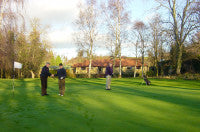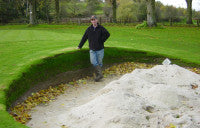Masham beats the Fus
 Despite a limited budget and some of the warmest, wettest conditions on record, two Yorkshire greenkeepers using careful soil and fertiliser management are winning a three-year fight against fusarium.
Despite a limited budget and some of the warmest, wettest conditions on record, two Yorkshire greenkeepers using careful soil and fertiliser management are winning a three-year fight against fusarium.
Andrew Percival and Neil Austwick, joint Head Greenkeepers and the only green staff at Masham Golf Club, a scenic, nine-hole parkland course just inside the Yorkshire Dales had been dealing with the twin problems of shallow rooting on their greens and a constant recurrence of disease. "Four years ago we couldn't put a tine on the 3rd., 7th., or 8th., because of poor rooting," says Andrew "and we were constantly getting hit with fusarium between September and April. You could spray five or six times during this period but it would go away and just come back."
David Snowden, European Technical Director of Floratine had become a member, but initially was reluctant to get involved. "Masham is my local club," he confides "but as the Green Chairman is a friend and he works closely with his green staff I decided to offer my support."

Snowden took soil samples in the autumn of 2003 and sent them to Analync, the American laboratories used by Floratine. "The analysis showed that we were very high in organic matter, nitrogen and iron and low in all other macro and micro nutrients," Andrew remembers. "We had too much water in the top two and a half inches of the root zone and this was encouraging the fusarium.
We used the penetrant Pervade, to take the water through, and TriCal 35SP, a form of pure available calcium, applying every four to six weeks that first winter." "Masham had a lot of residual and NH4 nitrogen," explains Snowden. "NH4 is an ammoniacal form that stays around longer. Although we desperately needed to aerate the upper root zone, to do this at this stage would have exacerbated the situation. The gas exchange created by the tining would have released too much nitrogen resulting in a flush of growth and a weak sward, particularly susceptible to a disease attack."
The following April the greens were treated to a minimal foliar feed of Protesyn, which helps regulate nitrogen conversion and provides amino acids, Per 4 Max to improve plant density and scaring, Renaissance a micro nutrient package and a small amount of Soluble Potassium Nitrate. "This was all we used right through the summer," continues Andrew. "We wanted to clean the soil of NH4, and we let the greens feed themselves. Twice during the year we used Calphlex, which solubises the calcium in the soil and releases other nutrients including nitrogen (NH4)."
The winter of 2004 saw the same treatment as the previous year, but in Spring Carbon Power and PK Fight were added to the combination of Per 4 Max, Protesyn and Renaissance. "We were striving to get the plant to take in nutrients," recalls Snowden "and Carbon Power, which is unique to Floratine increases the speed of uptake and translocates the movement of nutrients through the plant. P K Fight is a form of stable Phosphite, which the plant normally has to convert from Phosphorous. We wanted to prepare the plant for the season ahead and give it as much support as possible."
 At last, Neil and Andrew were beginning to see positive results. "The greens greened up and put roots down," Andrew remembers. "This reduced the stress of play. With nine holes, each hole gets twice as much use as those on an eighteen-hole course.
At last, Neil and Andrew were beginning to see positive results. "The greens greened up and put roots down," Andrew remembers. "This reduced the stress of play. With nine holes, each hole gets twice as much use as those on an eighteen-hole course.
Our Seniors Open, Rabbit's Open (a handicap tournament for over 16yrs), Ladies open, Men's Open and Mixed Open are all held within a fortnight of each other and P K Fight helps the plant cope with a lot of play and a lot of cutting. We foliar fed as and when, roughly every three to four weeks." Their old enemy fusarium was also less of a problem. "Over that second winter the fusarium was getting less," Andrew continues. "We came out of it a month earlier and had good greens by mid March."
The next winter was even better. "We continued using Trical and Pervade but there was really no fusarium at all," he says. "In January 2006 we bought a Charterhouse Vertidrain and verti-drained between five and seven inches down on every green. We now had sufficient rooting. The sward had put on an inch and a half in two summers."
Spring arrived last year at Masham bringing greens devoid of disease. "They were brilliant," confirms Andrew, "without a spot of fus. We continued the same programme as last year adding Astron a biostimulant to encourage even better rooting and Turgor before tournaments to strengthen the grass leaf and increase the ball speed. This had the desired effect and the greens coped with the demands of heavy play better than in 2005."
In early June, to combat the very dry conditions Andrew and Neil treated all the greens to five litres each of the soil amendments Retain, to retain moisture and Maxiplex to help improve nutrient availability. Protesyn was also applied as a foliar feed in the same quantities. Although fusariu
 m appeared in August with the heavy rain, the two head greenkeepers sprayed immediately and got rid of it. Snowden reports that the plant showed a quick recovery.
m appeared in August with the heavy rain, the two head greenkeepers sprayed immediately and got rid of it. Snowden reports that the plant showed a quick recovery.
"Masham has embraced the whole concept of reducing fungicides although it is not a big budget course," he says. "The greens are now free draining, and although we've had one of the wettest autumn and winter periods for years - 300mm to 400mm of rain in two to three weeks - this is the first time we've not been on temporary greens."
"We're aiming for good greens throughout the year" adds Andrew "and they're unfolding in front of our eyes. People come back year on year and say that they're different again."
For further information on Floratine contact David Snowden on Tel: 01765 658021 Email: dpsfpg@aol.com
Article Tags:
Golf


